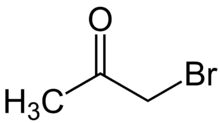- Bromoacetone
-
Bromoacetone[1]  1-BromoacetoneOther namesBromoacetone
1-BromoacetoneOther namesBromoacetone
1-Bromo-2-propanone
α-Bromoacetone
Acetonyl bromide
Acetyl methyl bromide
Bromomethyl methyl ketone
Monobromoacetone
Martonite
BA
UN 1569Identifiers CAS number 598-31-2 
PubChem 11715 ChemSpider 11223 
ChEBI CHEBI:51845 
ChEMBL CHEMBL1085947 
RTECS number UC0525000 Jmol-3D images Image 1 - BrCC(=O)C
Properties Molecular formula C3H5BrO Molar mass 136.98 g mol−1 Appearance Colorless lachrymator Density 1.634 g/cm³ Melting point -36.5 °C, 237 K, -34 °F
Boiling point 137 °C, 410 K, 279 °F
Vapor pressure 1.1 kPa (20 °C) Hazards MSDS MSDS at ILO Flash point 51.1 °C  (verify) (what is:
(verify) (what is:  /
/ ?)
?)
Except where noted otherwise, data are given for materials in their standard state (at 25 °C, 100 kPa)Infobox references Bromoacetone is a chemical compound with the formula CH3COCH2Br. This colorless liquid is a lachrymatory agent. It is a precursor to other organic compounds.
Bromoacetone was first prepared in the 19th century.[2] It was used in World War I as a chemical weapon, called BA by British and B-Stoff (white cross) by Germans. Due to its toxicity, it is obsolete as a riot control agent and is not used anymore.
Contents
Occurrence
Bromoacetone is naturally present (less than 1%) in the essential oil of a seaweed from the vicinity of the Hawaiian Islands.[3] In atmosphere it is degraded by the photochemically produced hydroxyl radicals.
Synthesis
Bromoacetone is available commercially, sometimes stabilized with magnesium oxide.
Bromoacetone is prepared by reacting bromine and acetone,[4] with catalytic acid. If you use a base you will obtain bromoform instead. H3 C(O)CH3 + Br2 → CH3C(O)CH2Br + HBr
As with all ketones, acetone enolizes in the presence of acids or bases. The alpha carbon then undergoes electrophilic substitution with bromine.[5] The main difficulty with this method is over-bromination, resulting in di- and tribrominated products.
Applications
Bromoacetone is a versatile reagent in organic synthesis. It is, for example, the precursor to hydroxyacetone (b.p. 35–47°/12 mm, CAS #116-09-6).[6]
See also
- Use of poison gas in World War I
References
- ^ Merck Index, 11th Edition, 1389
- ^ Sokolowsky, Berichte volume 9, pp. 1687 (1876).
- ^ B. Jay Burreson, Richard E. Moore, and Peter P. Roller (1976). "Volatile halogen compounds in the alga Asparagopsis taxiformis (Rhodophyta)". Journal of Agricultural and Food Chemistry 24 (4): 856–861. doi:10.1021/jf60206a040.
- ^ Levene, P. A. (1943), "Bromoacetone", Org. Synth., http://www.orgsyn.org/orgsyn/orgsyn/prepContent.asp?prep=cv2p0088; Coll. Vol. 2: 88
- ^ William Reusch. "Carbonyl Reactivity". VirtualText of Organic Chemistry. http://www.cem.msu.edu/~reusch/VirtualText/aldket2.htm. Retrieved 2007-10-27.
- ^ Levene, P. A.; Walti, A. (1943), "Acetol", Org. Synth., http://www.orgsyn.org/orgsyn/orgsyn/prepContent.asp?prep=cv2p0005; Coll. Vol. 2: 5
Categories:- Organobromides
- Lachrymatory agents
- World War I chemical weapons
- Ketones
Wikimedia Foundation. 2010.
